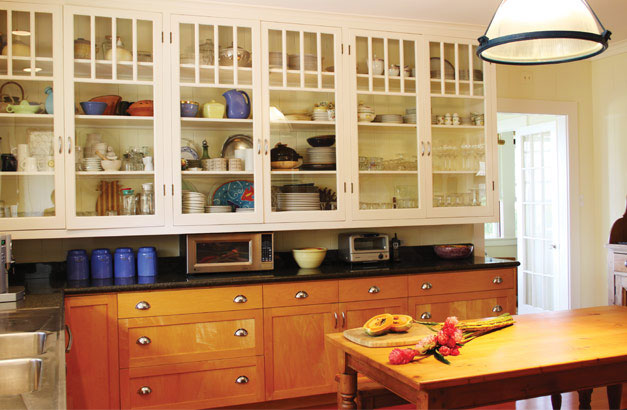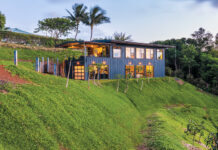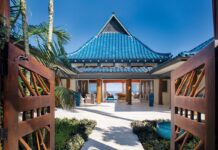Story by Rita Goldman | Photography by Nina Kuna
 In the early decades of the twentieth century, the stretch of Baldwin Avenue between Makawao town and Rainbow Park was known as Sunnyside. The stately homes along its winding length are what we imagine when we think of the island elegance of plantation-era Hawaii. As well we might—Maui Pineapple Company built and maintained these homes for its managers and top-echelon employees. In this same neighborhood sits Kaluanui Estate, the 1917 mansion that famed Hawaii architect C. W. Dickey designed for Harry and Ethel Baldwin, and that today houses Hui Noeau Visual Arts Center. Driving past, you can almost imagine the horse-drawn carriages, and later the tin lizzies rattling up to the port cocheres of some of the larger homes, dropping off Maui society for an evening’s soiree.
In the early decades of the twentieth century, the stretch of Baldwin Avenue between Makawao town and Rainbow Park was known as Sunnyside. The stately homes along its winding length are what we imagine when we think of the island elegance of plantation-era Hawaii. As well we might—Maui Pineapple Company built and maintained these homes for its managers and top-echelon employees. In this same neighborhood sits Kaluanui Estate, the 1917 mansion that famed Hawaii architect C. W. Dickey designed for Harry and Ethel Baldwin, and that today houses Hui Noeau Visual Arts Center. Driving past, you can almost imagine the horse-drawn carriages, and later the tin lizzies rattling up to the port cocheres of some of the larger homes, dropping off Maui society for an evening’s soiree.
 By 1994, the year five of those houses went on the market, Maui Pineapple Company had become Maui Land & Pineapple, and the domicile that a long-time Maui couple named Lynn and Richard would fall in love with was showing its age.
By 1994, the year five of those houses went on the market, Maui Pineapple Company had become Maui Land & Pineapple, and the domicile that a long-time Maui couple named Lynn and Richard would fall in love with was showing its age.
“The house was built in 1935 for the plantation doctor,” says Lynn. “Then Dr. Burden lived here for years.”
Born in Tokyo to missionary parents, John Alfred Burden arrived on Maui in 1939 and worked as a physician at several island plantations. Fluent in Japanese, he served with distinction in military intelligence in the Pacific during World War II, and returned to Maui a much-decorated veteran who would become one of the island’s leading citizens.
“When he lived here, this was ranchland,” says Lynn. “His daughter Betsy remembers growing up in this home in the fifties, surrounded by cattle and trees.”
After the Burdens, the house sheltered a string of tenants, and even served as a workers’ dormitory before the plantation offered it for sale.
Lynn has vivid memories of her first peek inside.
 “The walls were painted plaster board with lath nailed every four feet to cover the seams, and the electrical had been rewired as if for single-wall construction; everything was visible. We removed the lath, coated the walls in drywall mud, and put the wiring back in the baseboards.”
“The walls were painted plaster board with lath nailed every four feet to cover the seams, and the electrical had been rewired as if for single-wall construction; everything was visible. We removed the lath, coated the walls in drywall mud, and put the wiring back in the baseboards.”
Typical of island homes of that era, the ceiling was Canec, a material made locally from bagasse, the pulpy residue of sugarcane.
“When we saw the ceiling, it was undulating,” Lynn laughs. “The interior of the house had been painted with white enamel. It looked like the inside of a refrigerator! We thought we’d have to replace the ceiling, but Mike Yasak, a genius painter, said no. ‘Paint it a flat white, and you won’t see the ripples.’ He was right.”
Warping isn’t the only problem with Canec. A couple of panels in the dining room had to be replaced after two of the men rewiring the attic took a wrong step and fell through. Happily, only their dignity suffered.
Time and climate had conspired against the windward side of the house, which called for a bigger renovation. That room, now Lynn’s home office, sat in the shade of a massive monkeypod tree, collecting moisture decade after decade. Lynn and Rich replaced the floor there. All the rest is original tongue-and-groove fir suffused with a ruddy glow.
It is now, anyway. When the couple moved in, linoleum covered the kitchen’s wood floor, and sixties-era Formica had supplanted the original lower cabinets.
“We tore all that out, and put in new bottom cabinets,” says Lynn. “Once we did, you could see how the beautiful old cabinets above, with their original glass doors, had bowed. Our fabulous carpenter got up into the ceiling, laid a plank up there, and used long screws to level the cabinets.”
 Given how much work it would take to restore the home to its original charm, Lynn and Rich were the ideal buyers. “We redid seven houses before we bought this one,” says Lynn. And she says there was never any doubt.
Given how much work it would take to restore the home to its original charm, Lynn and Rich were the ideal buyers. “We redid seven houses before we bought this one,” says Lynn. And she says there was never any doubt.
“We looked at all five houses up here, and this was the one we wanted. The layout is very livable; it’s not too big, not too small; and the air circulates well.Most of all, “this house had a friendly vibe the moment we walked in.”
That’s a quality Lynn and Rich have enhanced in the seventeen years they’ve lived here. Both are active in the community, so the house sees a lot of club meetings, get-togethers, and parties that can number a hundred folks or more. (With five manicured acres of lawn, parking is never a problem.) One weekend in 2008, the kitchen and dining-room tables and every other nook and cranny in the home were occupied with volunteers making phone calls on behalf of Candidate Obama.
That sense of community exists even when no one else is around. Lynn and Rich are staunch supporters of local artists and craftspeople, and much of the art and many of the furnishings were made by familiar Maui names.
“Many of them are our neighbors,” says Lynn, reeling off a Who’s Who of respected artists living nearby: painters Eddie Flotte, Cynthia Conrad, Deybra Fair, Piero Resta; sculptors Tom Faught and Tim Garcia; woodworker Tom Calhoun. “Hui Noeau is down the road; Viewpoints Gallery is right up the street.”
 Other art reflects the couple’s penchant for travel: to (deep breath) Burma, Mongolia, Fiji, Kiribati, Argentina, China, Cuba, New Zealand, Japan, Costa Rica, Yucatan, South Africa, Kenya . . . “Five weeks in Botswana with the kids in an RV!”
Other art reflects the couple’s penchant for travel: to (deep breath) Burma, Mongolia, Fiji, Kiribati, Argentina, China, Cuba, New Zealand, Japan, Costa Rica, Yucatan, South Africa, Kenya . . . “Five weeks in Botswana with the kids in an RV!”
“Every year we do a big trip. Rich likes to go to places that are in transition politically or socially—though not completely unstable. The unexpected is what makes a trip interesting. We like culturally and historically interesting places.”
From those travels have come three impromptu collections: handmade rugs, sculpted heads, and paintings.
“We found a beautiful runner in Oaxaca made with vegetable dyes, little wool rugs in Chile and the Navajo nation. The painting over the fireplace was in the Stanley Market in Rangoon, Burma; it was on the floor of the market.” She points to another painting, over “floating” shelves crafted by Maui furniture maker Peter Naramore. “That’s a butcher shop in Russia. The painting was sitting on the street.”
Their third collection began when Rich’s high-school girlfriend gave him a sculpted head. “We started seeing heads everywhere,” says Lynn. “We got Mao’s in China, Lenin’s in Russia, Jesus’ in Cuba. . . .”
So much art that not all of it can be displayed at once; one of the pleasures of revisiting Lynn and Rich is seeing what’s different and new.
What doesn’t change is an inviting and unpretentious ease that makes the home something of a metaphor: like Hawaii, it has welcomed cultures from around the world, made room for them within its own island context, and created a community for all who enter.





